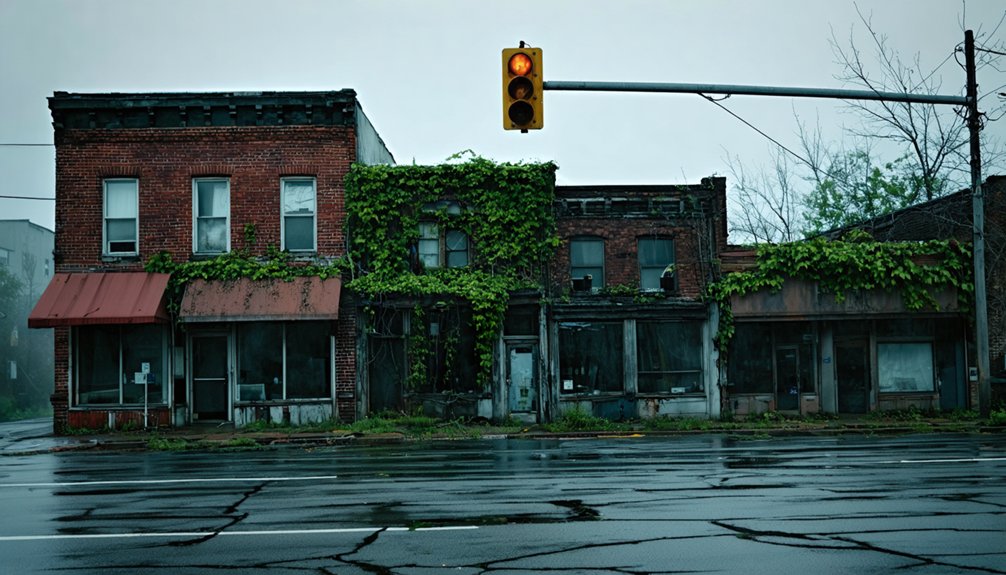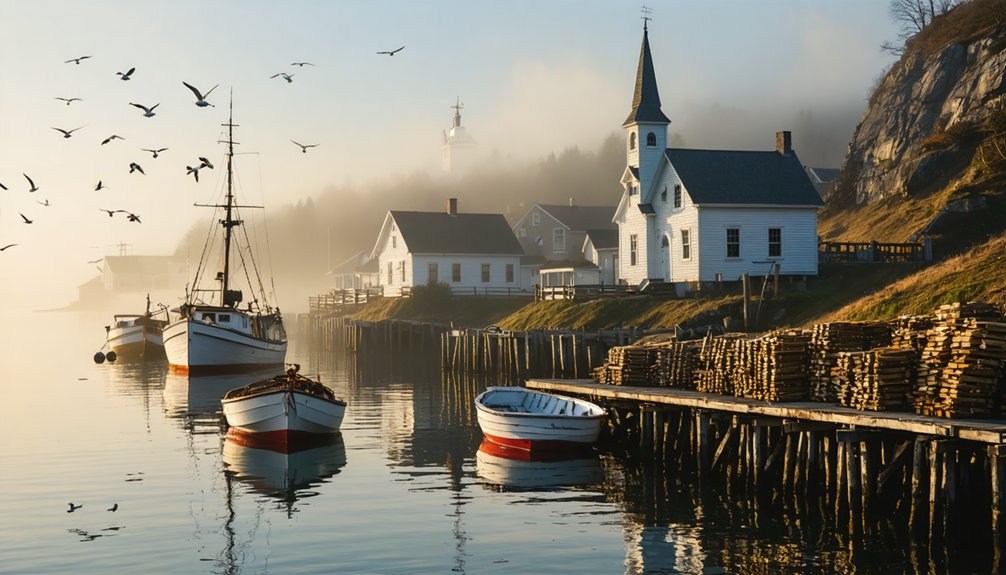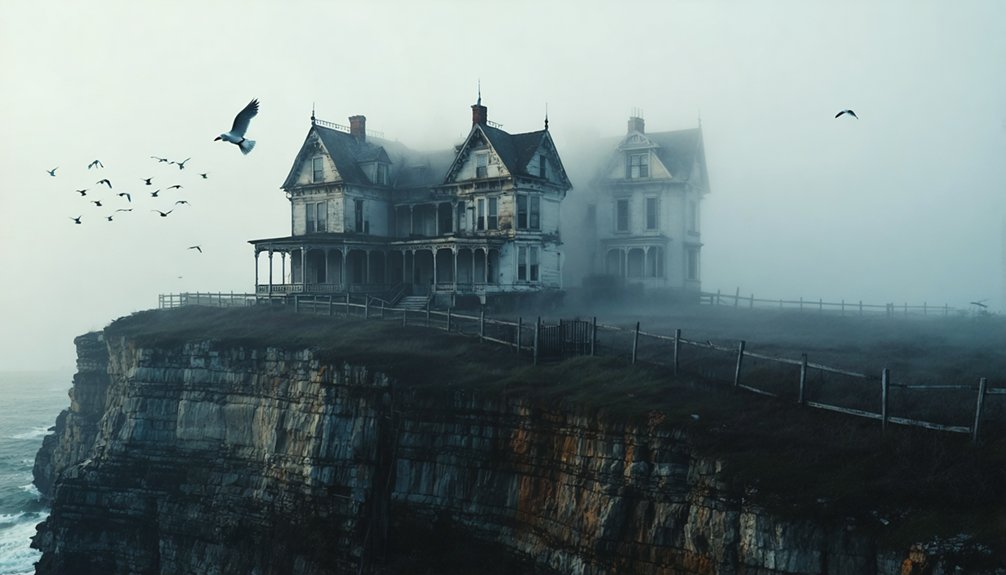You’ll find numerous eerie abandoned towns across the Eastern USA, from Centralia’s perpetual underground fire to Pennsylvania’s forgotten coal mining settlements. New England offers deserted Gilded Age resorts, while Appalachia features company towns swallowed by economic decline. The Eastern Seaboard presents historic ruins like mysterious Roanoke, and former psychiatric institutions stand as sobering monuments to changing medical practices. These ghost towns provide archaeological windows into America’s industrial, recreational, and medical past.
Key Takeaways
- Centralia, Pennsylvania harbors an underground coal fire burning since 1962 that could continue for another 250 years.
- New England’s abandoned resort villages like Glenside Park showcase the rise and fall of Gilded Age tourism destinations.
- Former company towns throughout Appalachia stand empty after mine depletion, including Thurman, West Virginia and Iron Gate, Virginia.
- Nature rapidly reclaims abandoned settlements such as Portsmouth Village’s maritime structures and Elkmont Historic District’s resort ruins.
- Former psychiatric institutions like Eastern State Hospital reflect changing medical practices with thousands of patients buried in unmarked graves.
Centralia: The Town Consumed by Underground Fire

Beneath the unassuming surface of Centralia, Pennsylvania, a cataclysmic environmental disaster has raged continuously since May 1962, when an improperly managed landfill fire ignited underground coal seams.
The fire origins trace to municipal trash burning in an abandoned strip mine lacking proper clay barriers, with flames accessing coal tunnels through a concealed opening. Experts predict the fire could burn for another 250 years, given the abundant coal deposits throughout the region. This catastrophe now spans approximately six square miles, advancing 75 feet annually along four fronts.
Negligent waste management unleashed a subterranean inferno that continues its relentless march beneath Pennsylvania’s abandoned coal country.
The underground hazards have rendered the area uninhabitable, with sulfurous fumes and carbon monoxide permeating the atmosphere while destabilizing the ground itself. Temperatures in the fire zone exceed 1,000 degrees Fahrenheit, creating an environment lethal to human life.
Despite multiple mitigation attempts—including wet sand injections and air pumping—the fire continues unabated.
Once home to nearly 3,000 residents, Centralia’s population dwindled to merely ten by 2012, a stark reminder of nature’s capacity to reclaim human settlements.
Coal Mining Ghosts of Pennsylvania
While Centralia represents Pennsylvania’s most infamous coal-town tragedy, the state’s landscape is dotted with dozens of lesser-known ghost towns that collectively narrate the rise and fall of America’s coal industry.
These abandoned settlements—Rausch Gap, Peale, Wehrum, Landrus, and Laquin—chronicle a complex mining history where resource depletion, economic shifts, and disease outbreaks forced rapid depopulation.
You’ll find haunting remnants scattered across Pennsylvania’s forests: concrete structures that resisted demolition, abandoned coke ovens, and forgotten cemeteries marking communities that once thrived.
Each ghost town tells a unique story of industrial boom and inevitable bust. The environmental legacy persists in abandoned mine lands, while cultural artifacts provide scholars critical insights into miners’ lives. The population in many of these towns dwindled to one-fifth or less of their peak numbers during the post-World War II economic decline. The eerie sight of smoke rising from cracks in pavement in Centralia serves as a stark reminder of the underground fire that has burned since 1962.
These settlements represent freedom’s paradox—the liberating prosperity of industrial growth followed by the necessity of migration when resources vanished.
Abandoned Resort Villages of New England

You’ll find Connecticut’s forgotten resort hamlets scattered throughout its verdant hills, where Gilded Age optimism once promised permanent prosperity.
These deserted destinations mirror the fate of other New England leisure communities, where economic downturns and changing vacation preferences left grand hotels and cottages to decay.
Connecticut’s abandoned resort architecture provides researchers with valuable insights into the transient nature of America’s early tourism industry. Much like Feltville’s transformation into Glenside Park under Warren Ackerman in 1882, these areas often began as working villages before being repurposed as fashionable summer retreats.
Many of these abandoned properties share architectural similarities with historic buildings like The Reefs Mansion, which was designed as a summer house but ultimately fell into disrepair before being demolished.
Echoes of Leisure Past
Throughout the late nineteenth and early twentieth centuries, New England’s landscape became dotted with resort villages that promised escape from urban industrialization, only to later fall victim to changing vacation preferences, economic downturns, and natural disasters.
You’ll find these resort remnants scattered across the East Coast, from New Jersey’s Glenside Park—originally Feltville, later transformed by Warren Ackerman in 1882—to New York’s Overlook Mountain House, a thrice-built monument to leisure nostalgia.
Vermont’s Ricker Basin and Glastonbury tell similar stories of ambitious leisure developments derailed by floods and economic collapse. The infamous Napatree Point in Rhode Island was once a thriving beach community before the devastating Hurricane of 1938 transformed it into a wildlife preserve.
Abandoned slate mining towns like West Castleton offer visitors glimpses of industrial history through dedicated history trails.
Even Perkins, Maine, with its wealthy summer residents, couldn’t survive the Great Depression’s impact.
These abandoned destinations reflect broader societal shifts—the democratization of tourism and transportation that redirected vacation patterns toward more accessible locales like the Jersey Shore, leaving once-thriving resorts to decay into historical curiosities within preserved parklands.
Connecticut’s Deserted Dreams
Despite Connecticut’s reputation for quaint coastal towns and manicured suburbs, the state harbors several forgotten resort communities that stand as weathered monuments to leisure’s impermanence.
These abandoned architecture marvels—Lincoln Lake Lodge, Sunrise Resort, and Johnsonville Village—represent distinct chapters in Connecticut’s historical narrative that await proper historical preservation efforts.
- The Grand View Hotel (later Lincoln Lake Lodge) shifted from family resort to cultural venue before succumbing to decay by 2011.
- Sunrise Resort’s 92-year legacy ended in 2008, leaving a government-owned property largely reclaimed by nature.
- Johnsonville Village evolved from Victorian mill community to ghost town, now owned by a religious organization.
Visitors exploring the 146-acre grounds of Sunrise Resort can still find remnants of vacation cabins and recreational facilities being slowly overtaken by forest vegetation.
Lincoln Lake Lodge once hosted notable music artists including Kool and the Gang and Curtis Mayfield during its heyday as a premier music venue.
These sites collectively illuminate the region’s industrial leisure heritage through their deteriorating structures and cultural remnants.
Lost Settlements of the Appalachian Mountains
The hidden valleys and remote ridges of the Appalachian Mountains harbor numerous abandoned settlements, each with a distinct narrative of rise and decline.
Lost Cove, North Carolina exemplifies community resilience, thriving as a self-sustaining agricultural settlement before transforming into a moonshine haven after 1910’s railroad arrival. Its final resident departed in 1957.
Company towns emerged with coal industrialization, only to wither as mines depleted.
Meanwhile, entire communities like Proctor and Loyston disappeared beneath reservoir waters during dam construction projects, their histories documented before submersion.
Thurman, West Virginia experienced meteoric growth in 1893 through mining and railroad commerce, but succumbed to fires and economic depression.
Similarly, Iron Gate, Virginia presents mere skeletal remnants of its industrial past.
These forgotten places represent the recurring pattern of exploitation and abandonment characteristic of Appalachia’s economic history.
Historic Ruins Along the Eastern Seaboard
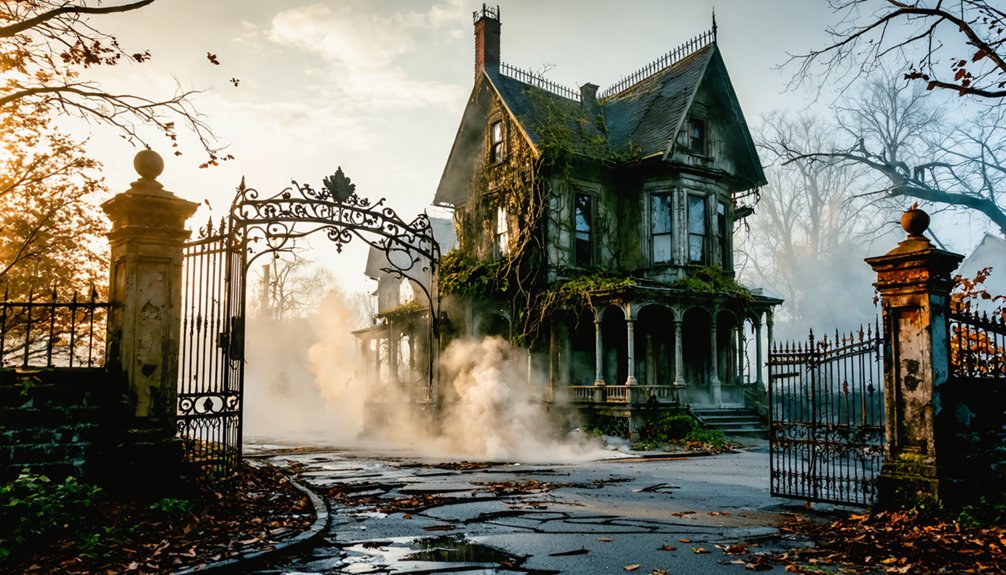
While abandoned communities dot the Appalachian highlands, equally compelling ruins await discovery along the Atlantic coastline. The Eastern Seaboard houses significant historic landmarks where preservation efforts have maintained the remnants of once-thriving settlements.
Beyond Appalachia’s ghostly remnants, the Atlantic’s forgotten towns whisper stories through their preserved ruins.
You’ll find Roanoke Colony’s mysterious disappearance marked only by the enigmatic “Croatoan” carving, while Sunbury’s ruins stand as evidence to Revolutionary War destruction that halted its rivalry with Savannah.
- Hanton City’s crumbling foundations offer scholarly insight into industrial decline when its mill ceased operations.
- Dudleytown’s cellar ruins and philosophical Babson boulders present analytical opportunities for cultural interpretation.
- Protected sites require visitors to respect established boundaries and artifact integrity.
- Guided historical tours provide academic context while allowing personal exploration of these freedom-defining abandoned spaces.
Towns Reclaimed by Nature
Nature’s relentless reclamation of abandoned human settlements offers profound insights into ecological succession processes throughout the Eastern United States. The moss-draped ruins of Cahawba, Alabama demonstrate how converging waterways accelerate urban decay, transforming former statehouses into verdant archaeological sites.
Similarly, Portsmouth Village’s maritime forests have methodically erased human footprints, with salt marshes advancing into deindustrialized spaces.
The Elkmont Historic District exemplifies temperate forest resilience, where hardwoods envelop mountain resort ruins.
Rose Island’s abandonment illustrates nature’s persistence in aquatic environments, as woodland dominates former recreational structures.
At Letchworth Village, institutional architecture surrenders to woodland encroachment, vines infiltrating broken windows.
These sites represent dynamic laboratories of nature reclamation, where ecological processes systematically dismantle human constructions, reasserting biological sovereignty over built environments.
Forgotten Industrial Havens of the East
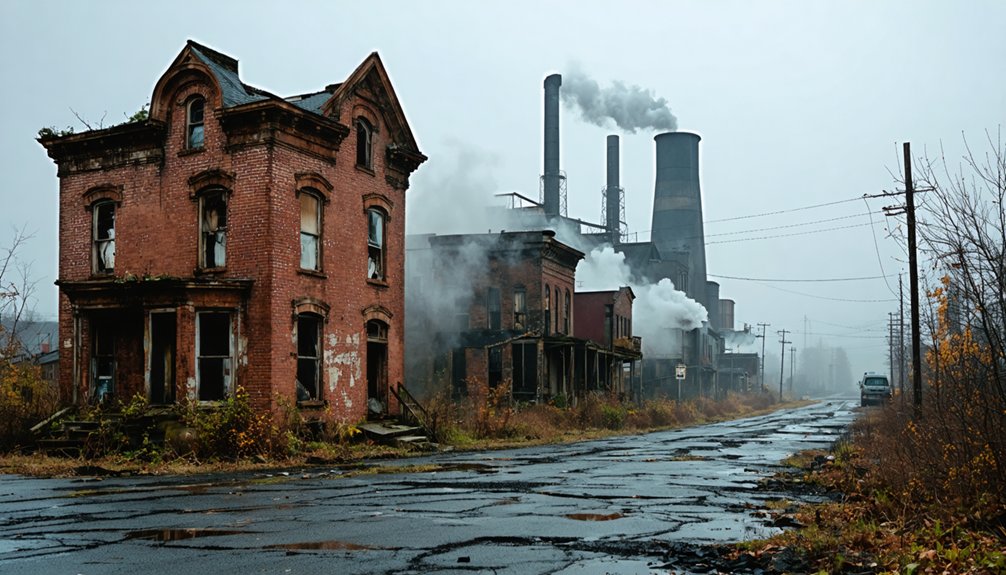
Across the eastern seaboard, abandoned industrial settlements stand as haunting monuments to America’s extractive economic history, where cycles of resource exploitation followed by environmental degradation created a distinctive pattern of community abandonment.
You’ll encounter these relics of industrial heritage throughout Pennsylvania, where Centralia’s underground coal fire continues burning since the 1960s, forcing government buyouts as toxic gases seeped into homes.
Similarly, economic decline transformed Eckley Miners’ Village into a living museum preserving 19th-century coal patch life.
- Elkmont Historic District showcases the aftermath of logging’s boom-and-bust cycle
- St. Elmo epitomizes mining settlements’ vulnerability to resource depletion
- Kennecott Mine illustrates copper extraction’s brief but intense economic impact
- Bodie represents the fragility of newspaper and railway infrastructure during industrial collapse
Eerie Hospital and Institutional Remains
Throughout America’s eastern states, abandoned psychiatric institutions stand as haunting monuments to changing medical paradigms and societal attitudes toward mental illness. These psychiatric relics once housed tens of thousands of patients but witnessed dramatic population declines—over 91 percent since the 1950s.
Eastern State Hospital in Kentucky exemplifies this institutional decay, with 4,000-10,000 patients buried in unmarked graves and most original structures demolished by 2014.
Similarly, Virginia’s Eastern State Hospital, the nation’s first public psychiatric facility (1773), saw its downtown campus razed in the 1960s-70s.
The systematic closure of abandoned asylums accelerated between 1998-2015, with Massachusetts, Maryland, Pennsylvania, and New Jersey shuttering multiple facilities.
These institutional remains constitute physical testimony to changing mental healthcare approaches, their crumbling infrastructure embodying both medical progress and forgotten lives.
Coastal Ghost Towns and Island Settlements
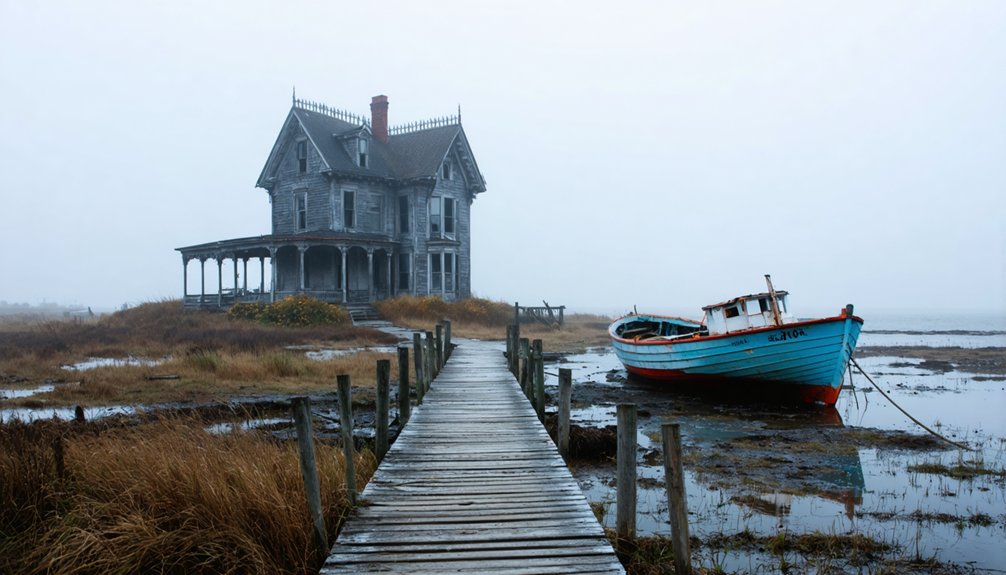
Along the Eastern Seaboard, abandoned coastal communities and island settlements tell a compelling story of human vulnerability against nature’s power and economic isolation. The architectural remnants—bleached silver by relentless salt air—evidence maritime decay and the transience of human occupation in challenging environments.
Coastal isolation ultimately rendered these once-vibrant communities unsustainable as economic opportunities dwindled and infrastructure deteriorated.
- Cape Lookout Village exemplifies the struggle against geographic remoteness, its wooden structures slowly surrendering to environmental forces.
- Roanoke Colony’s mysterious disappearance represents the earliest and most enigmatic American ghost settlement.
- Portsmouth Island’s preserved ruins offer scholars insights into historical coastal lifeways.
- Dudleytown and Dogtown demonstrate how isolation fostered unique folklore traditions that persist beyond physical settlement.
These abandoned locales constitute critical repositories of maritime heritage and environmental adaptation strategies worth scholarly examination.
Frequently Asked Questions
Are Any Abandoned Towns in the Eastern USA Legally Habitable Today?
Ever considered legal implications? Yes, some abandoned towns remain legally habitable, though you’ll need to navigate complex habitation regulations, verify utility access, and guarantee compliance with local zoning ordinances before establishing residence.
What Paranormal Activity Is Reported in Eastern Ghost Towns?
You’ll encounter apparitions, unexplained sounds, moving objects, and temperature fluctuations in eastern ghost towns. Ghost sightings commonly feature historical figures, while haunted locations like Union Cemetery and Bara-Hack manifest distinctive paranormal phenomena.
How Do Local Governments Manage Tourism in Dangerous Abandoned Sites?
While you might resent tourism restrictions, they’re necessary. Governments implement safety regulations, require permits, limit group sizes, and maintain emergency protocols while balancing preservation needs with your desire to explore these historically significant spaces.
Can Visitors Legally Collect Artifacts From Eastern Abandoned Towns?
No, you can’t legally collect artifacts from abandoned towns without proper permissions. Artifact preservation laws carry serious legal implications including fines and imprisonment, whether on federal, state, or private lands.
Which Eastern Ghost Towns Have Ongoing Preservation or Restoration Efforts?
Like sentinels of history, Thurmond (West Virginia) and Elkmont (Tennessee) boast significant preservation projects through National Park Service oversight, while restoration funding sustains Bodie, Ashcroft, and Fairbank’s architectural integrity for your exploration.
References
- https://www.loveexploring.com/gallerylist/131658/abandoned-in-the-usa-92-places-left-to-rot
- https://www.geotab.com/ghost-towns/
- https://albiongould.com/ghost-towns-to-visit-in-the-states/
- https://www.frrandp.com/p/ghost-towns-map.html
- https://en.wikipedia.org/wiki/Lists_of_ghost_towns_in_the_United_States
- https://www.legendsofamerica.com/gt-ghosttownseast/
- https://www.atlasobscura.com/lists/americas-best-preserved-ghost-towns
- https://traveloregon.com/things-to-do/culture-history/ghost-towns/
- https://www.youtube.com/watch?v=Z69cNeuZGsA
- https://www.britannica.com/video/coal-mine-fire-Pennsylvania-Centralia/-207717
